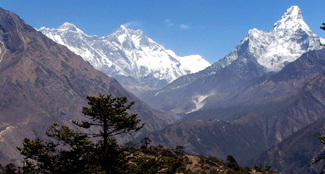| |
| |
| Sir Edmund Hillary help to create Sagarmatha National Park, a World Heritage Area in the Everest region of Nepal. This tribute was sent by Mountains Biome Network Member Bruce Jefferies, who helped with the creation of the Park, attended the Hillary funeral, and later shared these thoughts at a New Zealand Alpine Club event. Ed's contribution to the establishment of From Bruce Jefferies There is no doubt that the work of Ed's Himalayan Trust in relation to health, education and practical things such as bridges and water supplies were, and still are, key elements of the HT program which provide ongoing support to Sherpa communities in the Khumbu Less talked about, in fact hardly mentioned in the media but arguably of equal significance and importance, was Eds influence and guiding hand during the establishment of Sagarmatha (Mt. Everest) National Park and World Heritage Area. An early suggestion for establishing this iconic place as a national park came from Louise Hillary in one of her books. In 1973 the Government of Nepal announced their in-principle decision to establish the park and in 1974 an appraisal mission from New Zealand which included Bing Lucas, Sir Ed's climbing companion Norman Hardy and Ross Hodder undertook a mission to evaluate the feasibility for establishing the national park. I still have this report! 1975 saw a commitment from the New Zealand Government (undoubtedly with Eds guidance) to provide assistance to help set up the park. Over the following years, with support from their wives and families, several people provided park management and forestry advice. I spent more than 5 years living and working in Nepal and have returned several times with Marg and friends. Following the disastrous fire at Tengboche in 1989 I was with Ed at the site. Without hesitation Ed offered the Rimpoche support and an assurance that the Gompa would be rebuilt. No conditions - no if or buts - it would be rebuild! As you all know it bloody well was! Ed visited us on many occasions to discuss the work we were doing and to share his perspectives. I was aware that he had reservations about some aspects of the way the park was being managed by the government but his willingness to listen and provide support for the conservation efforts that were being made were boundless. The statement made by one prominent Sherpa to him about the establishment of the national park in relation to proposed restrictions on forest use did not help. This suggested that Ed had brought sugar to them in one hand, referring to health and education projects, and was now throwing salt in their eyes with the other, referring to the restrictions that the Nepalese Government was phasing in to manage forests and grazing lands. I reflect each time I return to Khumbu on what the area would be like if the hard choices had not been made! SNP is not a perfect example but it's pretty good and surely a better place than it would have been without the leadership Ed provided at a time when protected areas and conservation were seen as a negative force - not unlike our own experiences in NZ I guess! In 2006 Marg rewrote the Sagarmatha National Park Handbook - Highest Heritage (an earlier hand book had been produced in 1985). Eds foreword summarizes his perspectives on Sagarmatha National Park as well as his lifelong commitment to the Sherpa people. A couple of extracts are relevant: As with the rest of our planet much has changed in that time. The tiny summer settlements, of only a few basic shelters where the Sherpa's stayed while their cattle grazed the high pastures in summer, now sprout large lodges to accommodate the thousands of visitors who come to Khumbu each year. Thanks Ed for your leadership, friendship and blunt pragmatic guidance!
Care for the land, Care for the people, Go forward. --Bruce Jefferies | ||


